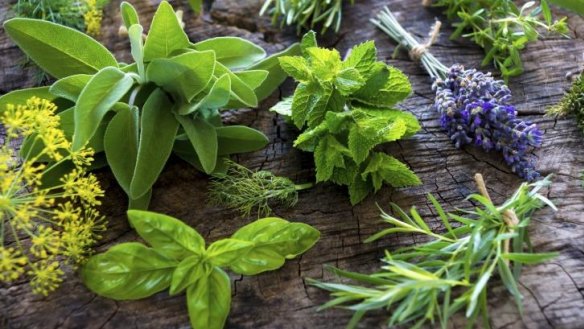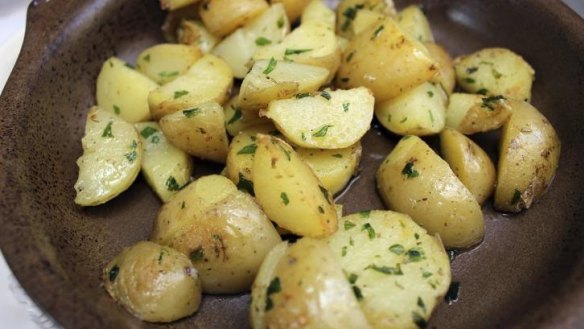How to grow parsley, sage, rosemary and thyme in Canberra gardens

It is now 50 years since Simon and Garfunkel released their song Scarborough Fair. The lyrics and the music still swim through my head when I pass our kitchen garden.
Four distinctly different plants but combined they can make good companions in the kitchen. At this time of year, they need very different attention. Together they can contribute to wonderful stuffings and casseroles. You can also sprinkle them over vegetables before grilling and you can enjoy their flavours with a roast. A slow roast or gentle simmering with a casserole or pot stew will bring out their full flavours.
Parsley is a very hardy annual which can grow with minimum care. Their dark green leaves are rich source of vitamins, including vitamin C and they provide good amounts of iron and other minerals. The older parsley plants are now going to seed and this process can be promoted as a way to have plenty of young, new plants growing up in the coming months.

There are plenty of stems with tender parsley now for the picking. Parsley is widely used in all Western countries as a garnish. For supplies of fresh young parsley over summer and autumn, grow as a border plant and provide some shade. It grows best in a deep, enriched garden bed or in a well-prepared pot. Remember to water regularly when days are hot and give the plants a regular seaweed or fish emulsion liquid fertiliser boost.
You can also keep supplies of parsley going over the winter months, by growing some plants in a sheltered but sunny location. Parsley does take quite some time to germinate so the self-sown seeds are a good option but if you do sow out some seed, plant it sparsely to a depth of 2cm and keep the soil moist until the little leaves appear. Plant directly where you want the parsley to grow because it does not like to be transplanted.
Sage is a pungent, aromatic herb coming from the Mediterranean and many of the sub species can withstand the winter elements. To get a good, bushy plant, you will need to regularly pinch out the tips of the plant. The common sage has green leaves and mauve blue flowers. This is propagated from seed in the early spring. The pineapple sage have green leaves with a reddish tinge. This sage needs to be well protected from frosts so you may well find it best to grow in a pot on the window sill. It is grown from cuttings.
Rosemary is a hardy bush which has been cultivated across the temperate regions of the Mediterranean for many centuries. Our rosemary bush is now quite large and has needed a big trim as it has enjoyed the hot summer.
Rosemary loves to grow in full sunshine but in the cold winter climate of Canberra it is best to grow it against a northern wall. Rosemary can be kept in pots and can also be used as a border hedge, with its evergreen foliage. There is a big selection of sub species that can provide either blue, pink or white flowers. All rosemaries need to be provided with very good drainage.
This is such a versatile culinary herb to use in the kitchen. Sprigs of rosemary with roast lamb provide a wonderful finished product. Add to your casseroles and even use it when making tomato dishes and sauces. Some supplies of our branches of rosemary have made their way to QT Capital Bar and Grill to hang in the dedicated dry aging chiller for the fine quality Cape Grim beef. The final product is imbued with the wonderful scent of rosemary.
Thyme is a lovely, hardy little perennial to grow in any kitchen garden and can be picked sparingly throughout the year. It actually needs to grow in poorish soil that is well drained, so do not load up the pot or garden bed with lots of compost. The leaves can be used fresh or dried in many, many dishes. There are many sub-species to choose from. Lemon thyme has quite large leaves with a distinct lemon scent. It is well used in fish and chicken dishes. Silver queen thyme also will provide a strong lemon scent to your cuisine. Caraway thyme produces rose coloured flowers and its little dark green leaves have a distinct caraway scent. It can be used in beef casserole dishes and stir fry.
You can easily set new plants by taking softwood cuttings of new growth thyme in spring and early summer. Select cuttings of 6-8 cm in length and in a basic potting mix.
Baked Potatoes with Herbs
600g nicola potatoes
600g pontiac potatoes
500g sweet potato
1 tbsp fresh parsley, finely chopped
1 tbsp fresh sage, chopped
sprigs of rosemary, stripped
1½ tbsp fresh thyme, chopped
5 garlic cloves, finely chopped
juice of 1 lemon
¼ cup olive oil
Salt and ground black pepper
Preheat the oven to 200C. Wash the potatoes well to remove all dirt but leave their skins on. Dissect large potatoes but keep smaller ones whole. Peel the sweet potato and slice into large chunks. Parboil for five minutes then drain and allow to dry.
Mix the parsley, sage, rosemary and thyme together and add the garlic. Place all the potatoes on a baking tray and scatter the herb mixture over them. Sprinkle with the lemon juice then drizzle olive oil over all. Season well with salt and pepper. Bake in the oven for 35-40 minutes, turning every 10 minutes. When golden brown, they are ready to serve.
This week in the Garden
Plant out English spinach, snow peas and field peas where you have cleaned up garden beds that have finished producing summer crops. There is time to also plant a fast growing crop of radishes and rocket.
If you leave your capsicums to colour up then you will have sweeter and hotter fruits for the kitchen.
Check your strawberry plants and trim off excess runners to ensure a good autumn harvest of fruit.
Mulch again with sugar cane mulch, or better still dry pine needles.
Keep adding all your weeding materials to the compost and seek out a supply of manures to add in.
Turn the compost again and ensure it has plenty of moisture to progress its decomposition.
Complete a late summer pruning of your apricot trees so that the cuts heal quickly and do not get diseased.
Owen Pidgeon runs the Loriendale Organic Orchard near Hall.